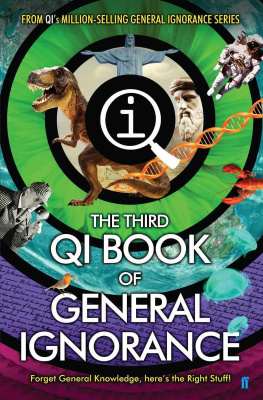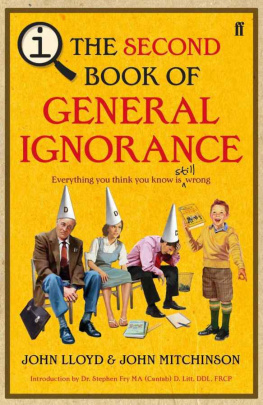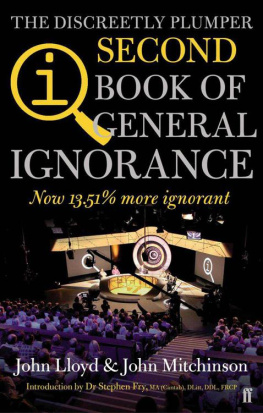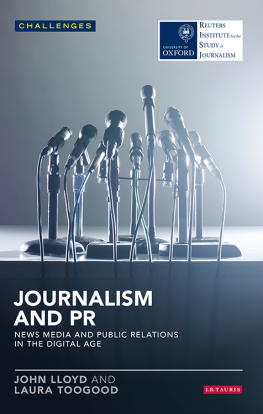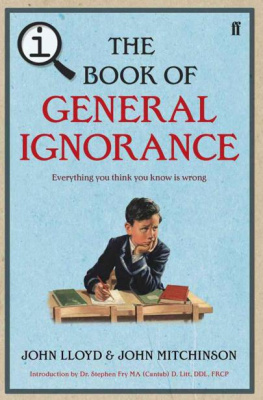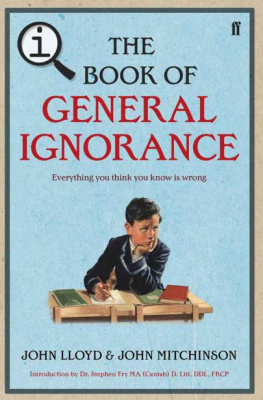John Lloyd - The Third QI Book of General Ignorance
Here you can read online John Lloyd - The Third QI Book of General Ignorance full text of the book (entire story) in english for free. Download pdf and epub, get meaning, cover and reviews about this ebook. year: 2015, publisher: Faber & Faber, genre: Science. Description of the work, (preface) as well as reviews are available. Best literature library LitArk.com created for fans of good reading and offers a wide selection of genres:
Romance novel
Science fiction
Adventure
Detective
Science
History
Home and family
Prose
Art
Politics
Computer
Non-fiction
Religion
Business
Children
Humor
Choose a favorite category and find really read worthwhile books. Enjoy immersion in the world of imagination, feel the emotions of the characters or learn something new for yourself, make an fascinating discovery.
- Book:The Third QI Book of General Ignorance
- Author:
- Publisher:Faber & Faber
- Genre:
- Year:2015
- Rating:5 / 5
- Favourites:Add to favourites
- Your mark:
- 100
- 1
- 2
- 3
- 4
- 5
The Third QI Book of General Ignorance: summary, description and annotation
We offer to read an annotation, description, summary or preface (depends on what the author of the book "The Third QI Book of General Ignorance" wrote himself). If you haven't found the necessary information about the book — write in the comments, we will try to find it.
The Third QI Book of General Ignorance — read online for free the complete book (whole text) full work
Below is the text of the book, divided by pages. System saving the place of the last page read, allows you to conveniently read the book "The Third QI Book of General Ignorance" online for free, without having to search again every time where you left off. Put a bookmark, and you can go to the page where you finished reading at any time.
Font size:
Interval:
Bookmark:


A Quite Interesting Book
General Ignorance
John Lloyd
John Mitchinson
James Harkin
Andrew Hunter Murray

Water is H2O, hydrogen two parts, oxygen one, but there is a third thing that makes it water and nobody knows what that is.
D. H. LAWRENCE
This is the third of the General Ignorance trilogy. Weve been thinking about it for three years. We never planned to write a trilogy: when we started out a decade ago, the idea of filling even one book with things we learn at school that just arent true seemed impossible. But today the magic jar of ignorance seems bottomless. So here it is: The Third Book of General Ignorance. The third leg of the stool. The balancing tome.
We wanted to compile a third volume for three reasons: first, because weve found so much great new material; second, because it somehow feels right. There is a third reason, but nobody knows what that is.
We humans seem mysteriously hardwired to think in threes: beginning, middle, end; body, mind, spirit; earth, sea, sky; small, medium, large; red, blue, green; A, B, C; Father, Son, Holy Ghost; here, there, everywhere; libert, egalit, fraternit; Tom, Dick, Harry; snap, crackle, pop!
Its a long and venerable inner waltz. Even our bodies, famed for their bilateral symmetry, are full of hidden threes: the skin has three layers (epidermis, dermis, hypodermis); our ears have three parts (outer, middle, inner); we have three types of teeth (incisors, canines, molars); there are three parts to our digestive system (stomach, small intestine, large intestine).
And the QI universe comes in triplicate: squids have three hearts; the lizard-like tuatara of New Zealand has three eyes; kangaroos have three vaginas and, as you will see if you read on, three legs.
The great minds of history have long been drawn to what the Greeks called a hendiatris (literally a one through three), or triple motto.
There are three classes of people: those who see; those who see when they are shown; those who do not see.
LEONARDO DA VINCI
There are three things that are extremely hard: steel, a diamond, and to know ones self.
BENJAMIN FRANKLIN
You can tell a lot about a person by the way they handle these three things: a rainy day, lost luggage, and tangled Christmas tree lights.
MAYA ANGELOU
No one has yet come up with a convincing psychological explanation for our attraction to threes and were not expecting one anytime soon.
Pythagoras, the first person to call himself a philosopher (in 520 BC ), believed three was the perfect number, the symbol of God, but even he struggled to explain why. Instead he advised, Do not go to bed until you have gone over the day three times in your mind.
Live, reflect, then ask more questions is the hendiatris we follow at QI. Weve learned much about many things but we start each new day in cheery ignorance. If this book, or the others in the General Ignorance threesome, inspires you to do likewise, our work here is done.
JOHN LLOYD, JOHN MITCHINSON,
JAMES HARKIN AND ANDREW HUNTER MURRAY
Its under the sea off Denmark.
In the traditional sense, the tallest waterfall in the world is Angel Falls in Venezuela. It plummets more than 3,000 feet: three times the height of the Shard building in London. The largest in terms of volume is the Guaira Falls, on the border of Brazil and Paraguay: every 90 seconds it dumps enough water to fill Lake Windermere, Englands largest lake.
But both of these pale into insignificance when compared with the height and the flow of an underwater waterfall in the Denmark Strait a section of sea between Iceland and Greenland that connects the Arctic and Atlantic Oceans.
The water in the Arctic is colder, denser and less salty than that of the Atlantic, and when the two bodies of water meet, they dont mix. As a result, when the Arctic water flows over the vast underwater cliffs separating it from the Atlantic, it sinks to the ocean floor. This creates an underwater waterfall almost three times the height of Ben Nevis, carrying 2,000 times as much water as Niagara Falls.
This gigantic water feature isnt there just to irritate pub quiz setters. As cold water flows out of the Arctic Ocean, warmer water is pushed up from the Atlantic along the west coast of the British Isles, with a hugely beneficial effect on the UKs weather. Even though London is further north than the Canadian ski town of Calgary, its generally a lot warmer.
The Angel Falls are so inaccessible that nobody outside Venezuela knew about them until the twentieth century. In 1933 an American aviator called Jimmie Angel flew over them; the falls are named after him, not the heavenly beings.
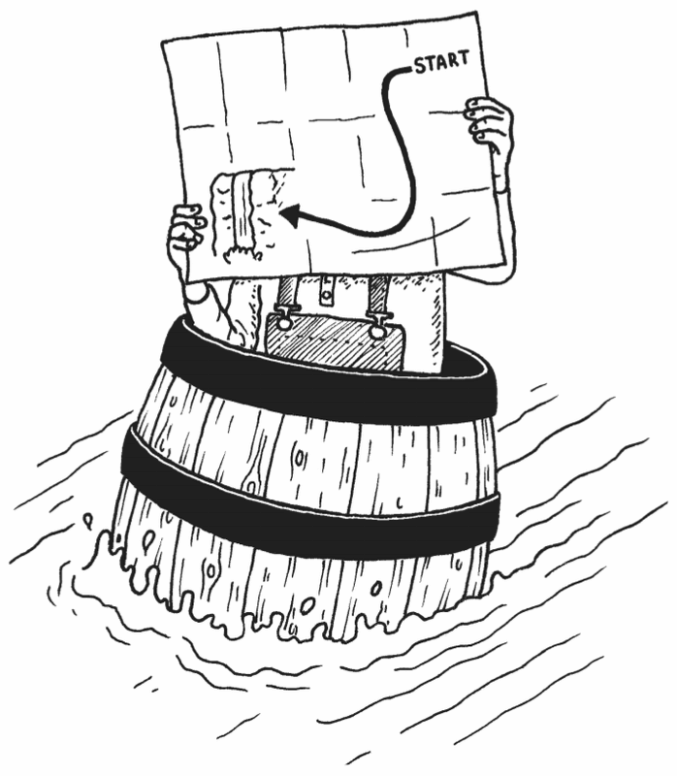
Angel returned to the falls four years later to confirm what he had seen, but when his plane landed it got stuck in mud. This meant Angel became not only the first Westerner to see Angel Falls but also the first person to descend the cliffs down which they fall. The location was so remote that it took Angel and his companions 11 days to get back to civilisation. His plane stayed at the top of the falls until 1970, when Venezuelan helicopters picked it up. Now fully refurbished, it stands in front of the airport terminal at Venezuelas southern capital, Bolivar City.
Thousands of feet up in the sky.
Everyone learns at school that the water cycle carries water vapour from the seas up into the atmosphere, from where it returns to Earth again as rain. But it wasnt until 1998 that scientists discovered that it flows in long narrow rivers in the sky. These atmospheric rivers are thousands of miles long and hundreds of miles wide. A large one can carry more water than the Amazon. There are four or five of them in the sky, somewhere in the world, at any one time.
Atmospheric rivers can cause disastrous floods if they suddenly release their water onto a specific area. The ten worst winter floods to hit Britain in the last 30 years were all caused this way. On the other side of the world, the west coast of America is also regularly hit by flooding from an atmospheric river known as the Pineapple Express, which stretches from Hawaii to California. In 1861 an atmospheric river brought 43 days of storms to California and turned its Central Valley into a 600-square-mile lake. Thousands died and the state was bankrupted and theres no guarantee it wont happen again.
The largest river thats not in the sky is deep underground. The River Hamza flows at just a millimetre an hour, 3 kilometres (2 miles) beneath the Amazon. The Hamza is thought to be the same length as the Amazon, but its much wider. Its less like a river than a system of porous underground rocks with water flowing steadily through them. Many geographers prefer to call it an aquifer.
Ignoring subterranean and stratospheric exceptions, everyone agrees the Nile is the planets longest river. It tops all the official lists at 4,152 miles long, followed by the Amazon at 4,000 miles. But the Amazon has recently got longer a huge blockage at its mouth has forced the water to find a new way to the sea, adding an extra 200 miles and allowing it to overtake the Nile.
Font size:
Interval:
Bookmark:
Similar books «The Third QI Book of General Ignorance»
Look at similar books to The Third QI Book of General Ignorance. We have selected literature similar in name and meaning in the hope of providing readers with more options to find new, interesting, not yet read works.
Discussion, reviews of the book The Third QI Book of General Ignorance and just readers' own opinions. Leave your comments, write what you think about the work, its meaning or the main characters. Specify what exactly you liked and what you didn't like, and why you think so.

